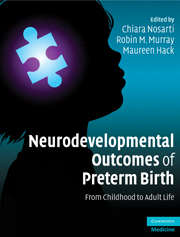Book contents
- Frontmatter
- Contents
- List of contributors
- Preface
- Section 1 Introduction
- Section 2 Neuroimaging
- 4 Imaging the preterm brain
- 5 Structural magnetic resonance imaging
- 6 Magnetic resonance imaging findings from adolescence to adulthood
- 7 Functional neuroimaging following very preterm birth
- 8 Diffusion tensor imaging findings in preterm and low birth weight populations
- Section 3 Behavioral outcome
- Section 4 Neuropsychological outcome
- Section 5 Applied research
- Section 6 Conclusions
- Index
7 - Functional neuroimaging following very preterm birth
from Section 2 - Neuroimaging
Published online by Cambridge University Press: 06 July 2010
- Frontmatter
- Contents
- List of contributors
- Preface
- Section 1 Introduction
- Section 2 Neuroimaging
- 4 Imaging the preterm brain
- 5 Structural magnetic resonance imaging
- 6 Magnetic resonance imaging findings from adolescence to adulthood
- 7 Functional neuroimaging following very preterm birth
- 8 Diffusion tensor imaging findings in preterm and low birth weight populations
- Section 3 Behavioral outcome
- Section 4 Neuropsychological outcome
- Section 5 Applied research
- Section 6 Conclusions
- Index
Summary
… we must not search for the physiological substratum of mental activity in this or that part of the brain but we have to regard it as the outcome of processes spread widely over the brain.
(De Watteville, quoted in [1], p. 17)Introduction
Mortality among very preterm (VPT) (e.g., < 33 completed weeks of gestation) and very low birth weight (VLBW) (e.g., < 1500 g) infants has significantly decreased in recent decades, particularly among the least mature individuals [2]. Very low birth weight infants are either born prematurely or are small for gestational age or both [3]. Therefore, VPT and VLBW individuals share several characteristics.
Alterations in key structural brain regions which have been reported in VPT and VLBW populations [4–9] may result in functional brain changes in distributed systems, underlying the long-term cognitive and behavioral sequelae often reported in these groups [9–13]. Functional neuroimaging investigations in VPT and VLBW individuals can therefore enhance the understanding of the mechanisms underlying the development of a variety of cognitive and behavioral problems in high-risk individuals, as well as the pathways to competent adaptation despite exposure to perinatal conditions of adversity.
Recent developments of functional neuroimaging techniques, based on measures of blood oxygenation and flow, have allowed the in vivo monitoring of metabolic changes in key brain structures and the neuroanatomical substrates of complex cognitive processes, providing new opportunities to advance the understanding of brain organization. In this chapter we will focus on investigations which have studied VPT and VLBW individuals with functional neuroimaging during different stages of development.
- Type
- Chapter
- Information
- Neurodevelopmental Outcomes of Preterm BirthFrom Childhood to Adult Life, pp. 76 - 96Publisher: Cambridge University PressPrint publication year: 2010



